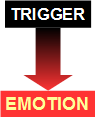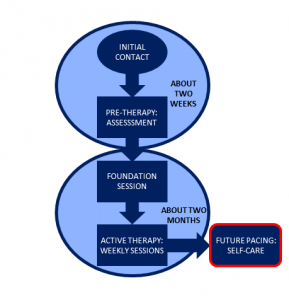Sequent repatterning therapy is one of a very few therapeutic techniques that has been developed specifically to treat misophonia. At its heart is the recognotion of the elements that make misophonia what it is and an understanding of the neuroscience that underpins sequent repatterning therapy.
A Model of Misophonia
This is the traditional perspective of misophonia. A sensory trigger causing an unwanted emotional reaction in an individual.
The commonly-held view is that a sound causes rage.
Just as we now know that the sensory experience can include any stimulus – something that is seen, heard, tasted, smelt or felt – we now know that the process involves distinct steps. The clear model of the condition is that is has five components and of those, three are key elements.
Some of these steps occur in the subconscious domain and that means that a person’s response begins before they are even aware that it is happening.
With an awareness of how misophonia affects individuals and considering the neuroscience of its process, a new model of misophonia is proposed: a sensory experience is responsible for a physical reflex and then an emotional response follows.
 Like all sensory inputs, what is usually termed the trigger enters into our subconscious; the sensory signals are processed in the limbic system of the brain. The limbic system does not think – it is part of our biology and not what we consider to be our thinking self. Through an acquired link a physical reflex is initiated – this can be a muscle jerk in the shoulders, or an arm or leg, for instance. It might also be a much less obvious reflex but it seems the physical reflex can be identified in an overwhelming majority of those with misophonia.
Like all sensory inputs, what is usually termed the trigger enters into our subconscious; the sensory signals are processed in the limbic system of the brain. The limbic system does not think – it is part of our biology and not what we consider to be our thinking self. Through an acquired link a physical reflex is initiated – this can be a muscle jerk in the shoulders, or an arm or leg, for instance. It might also be a much less obvious reflex but it seems the physical reflex can be identified in an overwhelming majority of those with misophonia.
At this stage the misophonia sequence enters into the conscious domain – we can be aware of the reflex but the behaviour – the way we respond – is already in process by now. The emotional state that occured as a biological process now becomes a conscious feeling – this is what psychologists call affect: the thinking experience of feeling emotions.
Every one of the individual components must exist before the misophonia process can be completed. But each time the sequence is experienced it becomes stronger and the links become more firmly established. The way a person feels and behaves becomes a stronger and stronger default response.
Rapidly changing levels of tension and stress, or of calm and peace, can affect the longer-term strength of the sequence. Feeling good and being calm and confident reduce severity.
The Therapy
Sequent repatterning is a therapy framework. That means it is not a rigid protocol but a series of interventions that can be applied to best-suit an individual. It is divided into three elements, usually called a Pre-therapy Phase, a Foundation Phase and an Active Therapy Phase.
The Pre-therapy Phase includes stepping through the seven-point misophonia diagnostic and completing a detailed assessment. Following Pre-therapy we usually plan a programme of about eight sessions. Those sessions are often each about an hour in length and weekly. Individual preferences and requirements may indicate more, shorter sessions to complete the programme, for instance.
The therapy begins by establishing a foundation on which later work can be based. The therapy is called sequent because it is a linked series of contiguous steps – like links in a chain – that each benefits from the  earlier interactions between client and therapist. Each session also paves the way for what is still to come. It is called repatterning because we don’t remove existing patterns of behaviour, leaving a void. We don’t endeavour to create new patterns that exist alongside old, unwanted patterns. That’s because when old networks remain in the brain they can be reactivated – sometimes through stress or trauma.
earlier interactions between client and therapist. Each session also paves the way for what is still to come. It is called repatterning because we don’t remove existing patterns of behaviour, leaving a void. We don’t endeavour to create new patterns that exist alongside old, unwanted patterns. That’s because when old networks remain in the brain they can be reactivated – sometimes through stress or trauma.
What we work towards is overwriting the misophonia emotional learning. Following detailed preparation the deep and unconscious drive to react to misophonia stimuli is replaced. A process know as memory reconsolidation – a fundamental aspect of the brain’s neuroplasticity – can be a powerful part of this transformational change process. How this is effectively achieved is a very personal process. Everyone is different!
If you are looking for a therapist to help with misophonia please go here

